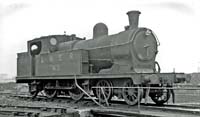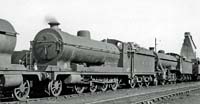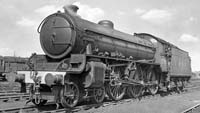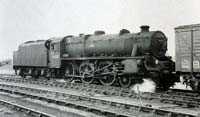 |  HISTORY |
Construction of the line began in 1895 and took several years to complete. The line stretched from Manchester (via Sheffield) to Marylebone Station in London, covering a distance of approximately 270 miles (435 kilometers). The engineering feat of the Great Central Main Line included the construction of tunnels, viaducts, and impressive stations along the route.
The line was officially opened for passenger services on 9 Mar 1899. It offered luxurious and innovative features for its time, such as electric lighting, steam heating, and a continental-style booking system. The Great Central Main Line gained a reputation for its high-speed services and luxurious accommodations, becoming known as the "London Extension".

However, the line faced financial challenges from the beginning. It struggled to attract the anticipated levels of passenger and freight traffic, leading to financial difficulties for the company. Despite efforts to increase revenue, including the introduction of suburban services and freight operations, the line struggled to turn a profit.
In 1923, the Great Central Main Line became part of the newly formed London & North Eastern Railway (LNER) as a result of the Grouping Act, which consolidated several railway companies in Britain. Under LNER, the line continued to operate, but changes in transportation trends, including the rise of automobile usage and increased competition from other modes of transport, began to impact its viability.
Ultimately, in 1966, the Beeching Report, which recommended the closure of many railway lines in Britain, led to the discontinuation of regular passenger services on the Great Central Main Line. Despite efforts by preservationists to save the line, the majority of it was closed and dismantled.
However, a section of the line from Loughborough to Leicester was saved and transformed into the Great Central Heritage Railway. The preservation project began in the early 1970s, with volunteers working tirelessly to restore the infrastructure, locomotives, and rolling stock. The heritage line officially opened in 1976, offering visitors the opportunity to experience the nostalgia of steam travel on a section of the former Great Central Main Line.
Since its establishment, the Great Central Heritage Railway has expanded its operations and facilities. It continues to be maintained and operated by dedicated volunteers who are passionate about preserving Britain's railway heritage and providing an authentic experience for visitors. The railway remains a popular attraction, offering a glimpse into the history and grandeur of steam travel in Britain.

As an AI language model, ChatGPT doesn't have real-time access to specific information or the ability to provide an up-to-date list of steam locomotives used by the Great Central Heritage Railway. However, it can provide a general idea of the types of steam locomotives that have been used on the heritage line. It's worth noting that the locomotives used can vary over time due to maintenance, restoration, and other factors. For the most accurate and current information ChatGPT recommends visiting the official website or contacting the Great Central Heritage Railway directly. Here are some examples of steam locomotive classes commonly associated with the Great Central Heritage Railway:
GCR Class 9K "Jersey Lillie": This locomotive, built in 1906, was originally designed for suburban services. It is notable for its distinctive streamlined appearance and has been restored and operated on the Great Central Heritage Railway.
GCR Class 8K "Director": These locomotives were built in the early 20th century and were mainly used for freight and heavy passenger services. A number of Class 8K locomotives have been preserved and occasionally operate on the Great Central Heritage Railway.
LNER Class B1: The Class B1 locomotives were designed by the London & North Eastern Railway (LNER) and were widely used for both passenger and freight services. Some examples of this class have been preserved and may have operated on the Great Central Heritage Railway.
LMS Class 5 "Black Five": The Black Fives were a versatile class of locomotives built by the London Midland & Scottish Railway (LMS). They were commonly used for various duties, including passenger and freight services. Some preserved Black Fives may have made appearances on the Great Central Heritage Railway.
These are just a few examples, and there may be other steam locomotive classes that have been used on the Great Central Heritage Railway at different times. To get the most accurate and up-to-date information, it's best to refer to the official sources associated with the railway.
NOTE: ChatGPT did not add the photographs or coloured drawings above.
Signal boxes are ubiquitous across British heritage railways. On a rail transport system, signalling is the means by which control is exercised over train movements by way of railway signals to ensure that trains operate safely over the correct route. Originally, all signaling was done by mechanical means. Points (switches or turnouts) and signals were operated locally from individual levers or handles requiring the signalman to walk between the various pieces of equipment to set them in the required position for each train that passed. Before long it was realized that control should be concentrated into one building, which came to be known as a signal box. The signal box provided a dry, climate-controlled space for a signalman and the complex mechanical interlocking mechanisms. The raised design of most signal boxes also provided the signalman with a good view of the railway under his control. The first use of a signal box was by the London & Croydon Railway in 1843 - Wikipedia.
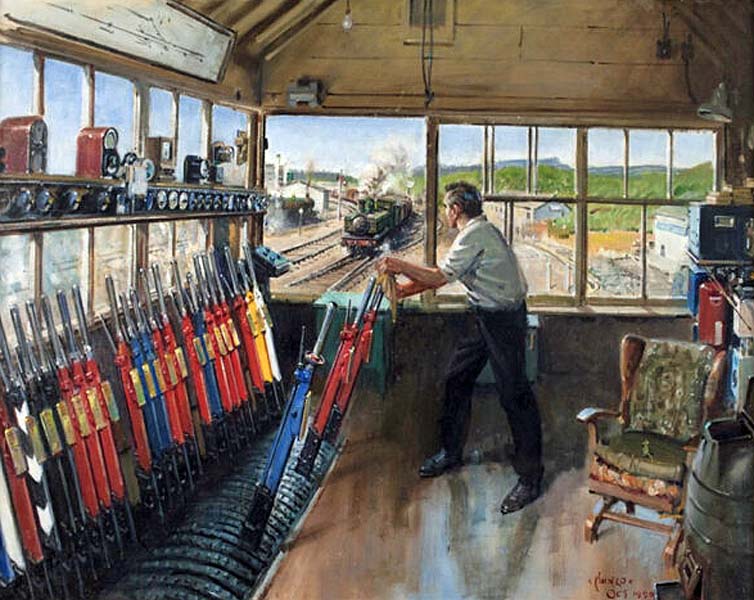
Heavy metal levers mounted in a ground frame connect to points via moveable rods. They also connect to signals via cables and pulleys. The varous levers are locked and unlocked by the ground frame according to rules built into the controlling mechanism. Think of the mechanism as an early computer which ensures points are not set to such a position that a derailment or worse might occur. This is called interlocking. The levers are colour coded to indicate various functions such as:
Red - Stop signals and shunt signals;
Red with a white stripe - Section signal interlocked with block instruments;
Yellow - Distant Signals. Pass at caution but the driver should expect the next signal to be at Danger;
Black - points. (Motor operated points incorporate the facing point lock into the point machine and don't have separate FPL levers.);
Blue - Facing Point Lock on points;
Brown - Gate locks and releases;
Blue over brown - Ground frame release;
Yellow over Red - The lever works a stop signal and its associated distant;
Brown with white stripes - Acceptance lever on single lines;
Green - King levers used when closing signal boxes at times of low traffic (GreatWestern only.) Historic and no longer used;
White - Spare;
White with upwards chevrons - Up line detonator placer;
White with down chevrons - Down Line detonator placer.
For a whole warren of interesting rabbit holes, try signalbox.org web site. For slightly less, but still with the basic principles and sense try romseysignalbox.org.uk - Neil Kearns.


